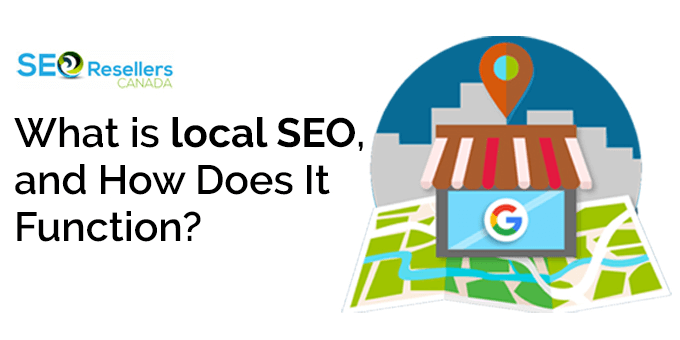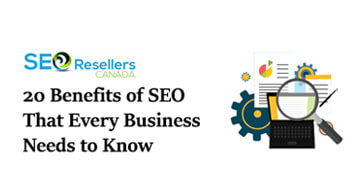The internet is pretty much the center of everything we do these days. It is shaping the way businesses connect with their audiences. Therefore, we need effective strategies or a trusted digital marketing agency to engage with potential customers. Digital marketing is gaining immense popularity over traditional approaches because it leverages online platforms. These platforms allow you to connect with customers and promote businesses. What is digital marketing? How can it boost your business? This blog covers informative content you need to learn digital marketing and grow your brand online.
WHAT IS DIGITAL MARKETING? – EVERYTHING YOU NEED TO KNOW ABOUT IT!
0.1- What is digital marketing?
Digital marketing is basically an online strategy that includes but is not limited to social media solutions. It revolves around establishing and maintaining connections with current and past customers. With these strategies, brands encourage customers for deeper engagement.
Digital marketing uses search engines to grow a brand. Other approaches include websites, email, social media, and mobile apps to reach a broad audience. Marketers use these channels to promote their services and products to individuals most likely to interact with their brand.
The essence of digital marketing lies in its ability to present tailored offers at the most opportune moments. Achieving this involves creating customized content designed to rank high on search engine pages and crafting relevant advertisements across various online platforms. Digital marketing is done with the following objectives:
1. Attracting New Clients: By employing targeted strategies, digital marketing draws in potential customers who are genuinely interested in the products or services being offered.
2. Making Loyal Customers: It focuses on cultivating and maintaining strong connections with both new and existing customers, fostering loyalty, and encouraging repeat business.
3. Positive client response: Digital marketing involves creating compelling and appealing offers that resonate with the target audience.
1- Digital marketing trends
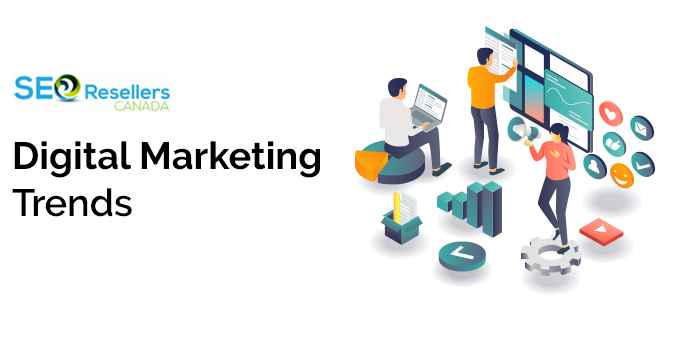
Digital marketing case studies illustrate how businesses adapt to emerging trends.
- Video Content Dominance: Short-form videos, live streams, and interactive content are gaining popularity. Small businesses can leverage platforms like TikTok, Instagram Reels, and YouTube to engage audiences.
- Social Commerce: Social media platforms also have options for online shopping. Small businesses can utilize Facebook Shops, Instagram Shoppable posts, and Pinterest Buyable Pins to increase sales through social media.
- Local SEO and Google My Business: There is a rise in “near me” searches. Local SEO and Google My Business profile should be optimized.
- Voice Search Optimization: Voice-activated devices become popular. Optimize content for voice searches and focus on natural language keywords.
- AI-Powered Chat bots: Small businesses can implement chat bots on their websites and social media pages, improving customer engagement and satisfaction.
- User-Generated Content: Small businesses can run contests, ask for reviews, or showcase customer stories to begin their digital presence.
- Micro-Influencer Partnerships: Collaboration with micro-influencers can be cost-effective for small businesses.
- Personalization and Data Privacy: Customers expect personalized experiences while also valuing their privacy. Small businesses can invest in data analytics to understand customer behavior and preferences.
- Sustainable and Socially Responsible Branding: Consumers increasingly support eco-friendly and socially responsible businesses. Small businesses can highlight their sustainable practices to build a positive brand image.
2- Types of digital marketing
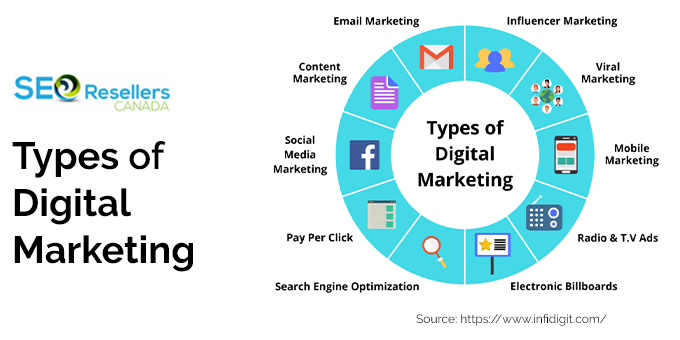
A brand can grow online by hiring a digital marketing expert or a link-building company. These agencies would use different types of digital marketing strategies. Wondering what are these growth tactics? Read on to find out.
2.1- Paid Search or Pay-per-Click (PPC) Marketing
PPC management services are where the advertisers pay for each user who clicks on their ads displayed across various platforms. These sponsored ads are seen at the top of Search Engine Results Pages (SERPs).
These PPC ads can be customized, which enables businesses to tailor their campaigns based on specific keywords. PPC is employed to create highly focused advertisements tailored to audiences likely to be interested in their offerings.
The flexibility of PPC ads makes them suitable for diverse organizations. Different platforms use demographic and interest-based targeting to create relevant audiences, driving substantial traffic to websites. Google Ads (formerly AdWords) is a prominent PPC channel.
Other impactful PPC platforms include:
- Facebook Ads: Businesses can customize video, image posts, and slideshows for targeted audiences. Sponsored posts, strategically placed in users’ newsfeeds, leverage Facebook’s massive user base of approximately 2.9 billion.
- X (formerly known as Twitter)Ads Campaigns: Advertisers can pay to display profile badges or a series of tweets to specific audience segments. This drives traffic to their websites and enhances brand interaction.
- Sponsored Messages on LinkedIn: LinkedIn allows businesses to send personalized direct messages to users based on their professional backgrounds and industry affiliations.
2.2- Search Engine Optimization (SEO)
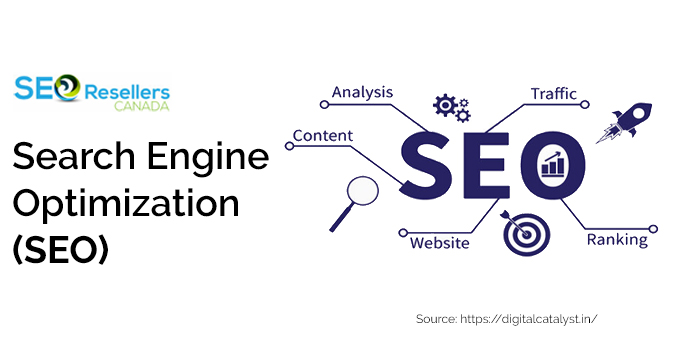
SEO is the process of optimizing your website’s reach, content, and technical setup to improve its ranking on search engine results pages (SERPs). You can hire a Victoria SEO company that uses industry-specific keywords to attract more visitors to your site.
SEO is a fundamental practice in digital marketing. SEO consulting ensures that your website is user-friendly, well-constructed, and features useful content. SEO-friendly and credible content enhances the likelihood of other websites linking to your content.
There are three types of SEO tactics employed by brands to grow their online presence.
On-Page SEO: This aspect focuses on optimizing the content within your web page. It is done by using well-researched industry keywords and long-tail questions searched by users on Google.
Off-Page SEO: Off-Page SEO involves activities outside your website that impact your ranking. It includes writing guest posts and obtaining backlinks from authoritative sites.
Technical SEO: This facet deals with the technical backend of your website. For instance, proper coding in HTML or image optimization and content structure with HTML headings.
2.3- Content Marketing
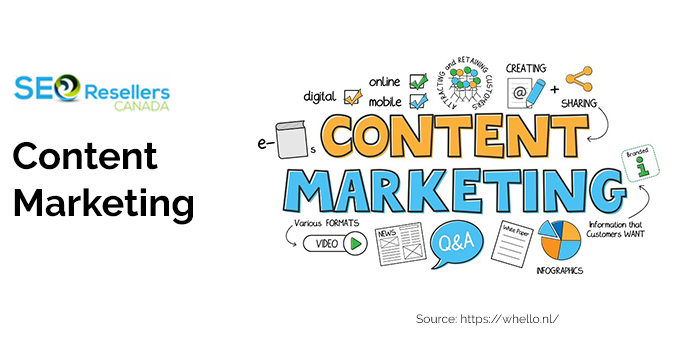
Content marketing is pivotal for a white label SEO agency. Content marketing educates and inspires the readers or the target audience. Brands promote high-quality and relevant content to boost their brands on social media platforms.
2.3.1- Content Marketing Channels:
- Blog Posts and Articles: Informative blog posts and articles attract organic search traffic and convert visitors into potential customers.
- Infographics: Visual representations engage visitors. They are processed by the human brain about 60,000 times faster than textual information.
- White papers and eBooks: Long-form content such as white-papers and eBooks establishes brand authority.
2.4- Social Media Marketing
Social media platforms are essential for brand investigation and customer engagement. Social media marketing involves reaching a large audience through various platforms using content marketing campaigns, videos, and paid ads. The goal is to create brand awareness, establish social trust, generate leads, and eventually convert engaged users into customers.
2.5- Email Marketing
Email marketing remains a potent tool with over 4.26 billion users. Approximately 93% of B2B marketers use emails to distribute content, promote events, share industry tips, and provide exclusive offers. Effective email campaigns are relevant, reliable, conversational, coordinated across channels, and strategic.
2.6- Mobile Marketing
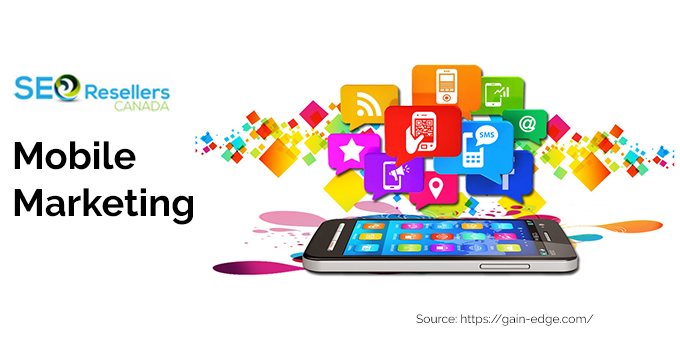
Mobile marketing leverages smartphones, focusing on in-app marketing to reach potential consumers. App stores like Google Play and App Store offer opportunities for promoting apps through paid advertising and cross-app promotions, increasing visibility and installations.
2.7- Video Marketing
Video marketing on platforms like YouTube is a popular approach. Marketers use pre-roll, skippable, display, and non-skippable video ads to increase brand awareness. YouTube made $29.24 billion in net advertising revenues.
2.8- Affiliate Marketing

Affiliate marketing involves promoting other businesses’ products and earning a commission for each sale or lead. Major companies like Amazon participate in affiliate marketing programs, paying commissions to affiliates for displaying their content and ads on other websites. Around 90% of marketers incorporate affiliate marketing into their digital marketing campaigns.
3- Benefits of digital marketing
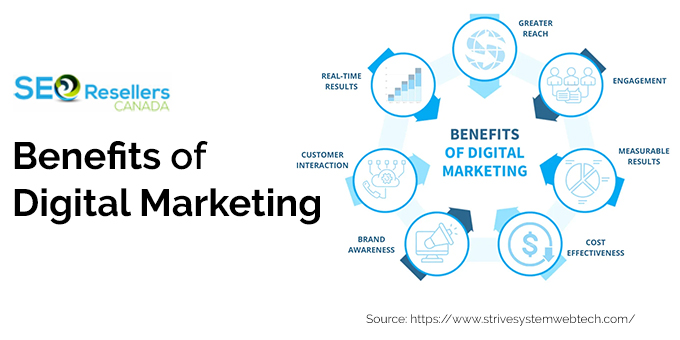
Digital marketing is important for the growth of any business. It offers several key benefits.
- Growth on a global level: Businesses can reach a vast global audience through digital marketing channels. It helps in creating brand awareness and generating leads on an international scale.
- Affordable solution: Online campaigns on platforms like Facebook and YouTube provide higher ROI. Digital marketing has a maximum impact on every dollar spent. It is done by targeting specific demographics and user behaviors.
- Viral Potential: Engaging and creative digital content has the potential to go viral swiftly. A well-crafted post on social media platforms like Facebook, Instagram, or X can be shared exponentially.
- Tailor-made campaigns: Brands can leverage data analytics and consumer insights to tailor their content. They can match the preferences and interests of specific customer segments to increase the likelihood of sales. As stated by Backlinko, understanding consumer behavior helps in increasing conversions.
- Quick and easy to measure results: digital marketing offers real-time tracking and measurable results. Businesses can monitor the performance of their marketing campaigns in terms of website traffic, engagement, conversions, and more.
4- How to do digital marketing on a budget?
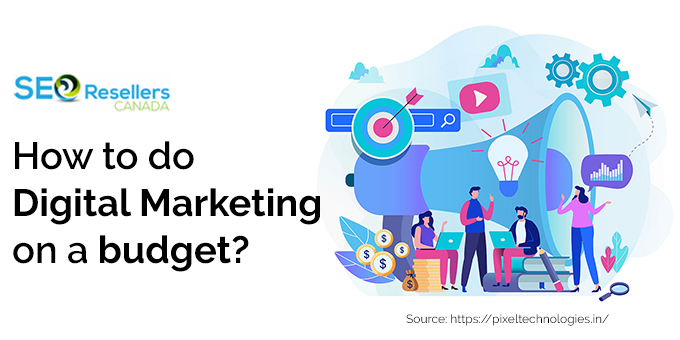
Executing an effective digital marketing strategy on a budget requires strategic planning and creativity. If you are looking for cost-effective solutions or strategies for digital marketing for small businesses, here is a quick guide for you.
- Audience Research: Understand your target audience’s online behavior and preferences for focused marketing efforts.
- Utilize Free or Low-Cost Platforms: Engage with your audience on social media platforms like Facebook, Instagram, and Twitter without hefty advertising costs.
- Create Compelling Content: Develop shareable content such as blogs, infographics, and videos to capture audience attention.
- Optimize for SEO: Enhance your website’s search engine optimization to increase organic traffic without spending on ads.
- Email Marketing: Implement cost-effective email marketing campaigns to nurture leads and maintain customer engagement.
- Influencer Collaboration: Partner with influencers in your niche for product promotion, often in exchange for free products or nominal fees.
- Data Analysis: Use free tools like Google Analytics to analyze website performance and refine marketing strategies based on data insights.
5- Digital marketing strategies for e-commerce businesses
Optimize your website and make it mobile responsiveness. Mobile commerce accounts for 72.9% of all e-commerce sales. You can also utilize SEO techniques to increase organic traffic by 20%. Include blogs and videos to establish brand authority and lead to 97% more backlinks. Leverage Facebook ads and reach 2.9 billion monthly active users. Email marketing can also provide an average return on investment (ROI) of $42 for every dollar spent. Implementing these practical strategies makes your brand visible and increases conversion rates.
6- Conclusion
Brands are competing in this digitized world; therefore, understanding digital marketing is essential. If you are aiming to thrive in the online sphere, delve into the multifaceted aspects of digital marketing. Propel your business by leveraging digital marketing channels, analytical tools, or SEO outsourcing. Whether through search engine optimization, compelling content, or social media outreach, the potential for reaching wider audiences is immense.
SEO Resellers Canada stands ready to assist brands that are seeking expert guidance. Our specialized digital marketing services encompass web design and social media solutions. The award-winning Kelowna SEO agency can catalyze your online presence and drive meaningful connections with your audience. Reach out to us today and elevate your digital marketing journey.
Editor’s Note: This post was originally published on March 05, 2020, and has been completely revamped and updated for accuracy and comprehensiveness.
For over 18 years we have been the solution to fit any size agency or business. Our team of creative SEO experts and marketers develop some of the best results driven campaigns in the industry.
E-Commerce Marketing Strategies to Boost Sales
The Ultimate Guide to Writing SEO-Friendly Content
A forward-looking digital marketing agency knows that content is the fuel that fires up success in SEO campaigns. It will be an understatement to say that high quality content is the catalyst that enables SEO success.
What Should You Consider When Developing Your Website Content?
You might have a well-made website, but is it getting the job done? Are you getting the traffic that you want? Well, there are many factors that go into website development and design to change a visitor into a paying customer.
What is local SEO, and How Does It Function?
The process of optimising your website for a particular local market is known as local SEO. Any SEO plan aimed at clients in a particular area, city, or neighbourhood must include a local search.
20 Benefits of SEO That Every Business Needs to Know
In the current business world, there are many advantages of search engine optimization, or SEO, and it is extremely important in establishing a successful business and in getting







